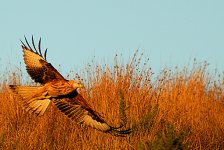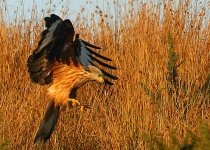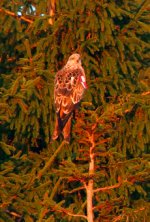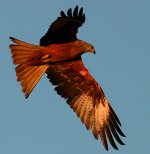Steve G
RAINBIRDER
A new Red Kite feeding station has opened up in Central Scotland. Whilst mainly of interest to those living in the central belt of Scotland anyone coming up from down south to visit Granny at Hogmanay should consider a visit.
The feeding station is overlooked by a comfortable spacious hide on a working farm in the Braes of Doune. The farm is managed to encourage birds & other wildlife & when I was there on 8/12/03 there was a huge mixed finch flock as well as large numbers of "winter thrushes", Starlings, Stock Doves,etc. The site opened at the end of November & has had few visitors as yet but already December's birdlist includes Peregrine, Hen Harrier & Waxwings as well as Sparrowhawks, Buzzards & over 30 Red Kites.
The Central Scotland population of Red Kites have had a tough time as a result of poisoning & to date the re-introduction programme has been outwith the public eye. Now however, the opening of this feeding centre allows the public first hand experience of these beautiful birds & hopefully the increased public awareness will put added pressures on those who poison (either by accident or intent) these birds.
Anyone wishing to visit Argaty should check out their website for directions & visiting information. Despite the information suggesting advanced booking, visits are quite a relaxed affair & the owners are very friendly however it is a working farm.
This project should be supported by local birders-not just for the Kites but also for the way this farm is being run to maximise local bird population. The owners should be applauded for showcasing their wildlife-friendly farm which will hopefully attract other farmers to manage their land likewise. :clap:
Argaty Red Kites website is: www.argatyredkites.co.uk
The feeding station is overlooked by a comfortable spacious hide on a working farm in the Braes of Doune. The farm is managed to encourage birds & other wildlife & when I was there on 8/12/03 there was a huge mixed finch flock as well as large numbers of "winter thrushes", Starlings, Stock Doves,etc. The site opened at the end of November & has had few visitors as yet but already December's birdlist includes Peregrine, Hen Harrier & Waxwings as well as Sparrowhawks, Buzzards & over 30 Red Kites.
The Central Scotland population of Red Kites have had a tough time as a result of poisoning & to date the re-introduction programme has been outwith the public eye. Now however, the opening of this feeding centre allows the public first hand experience of these beautiful birds & hopefully the increased public awareness will put added pressures on those who poison (either by accident or intent) these birds.
Anyone wishing to visit Argaty should check out their website for directions & visiting information. Despite the information suggesting advanced booking, visits are quite a relaxed affair & the owners are very friendly however it is a working farm.
This project should be supported by local birders-not just for the Kites but also for the way this farm is being run to maximise local bird population. The owners should be applauded for showcasing their wildlife-friendly farm which will hopefully attract other farmers to manage their land likewise. :clap:
Argaty Red Kites website is: www.argatyredkites.co.uk








